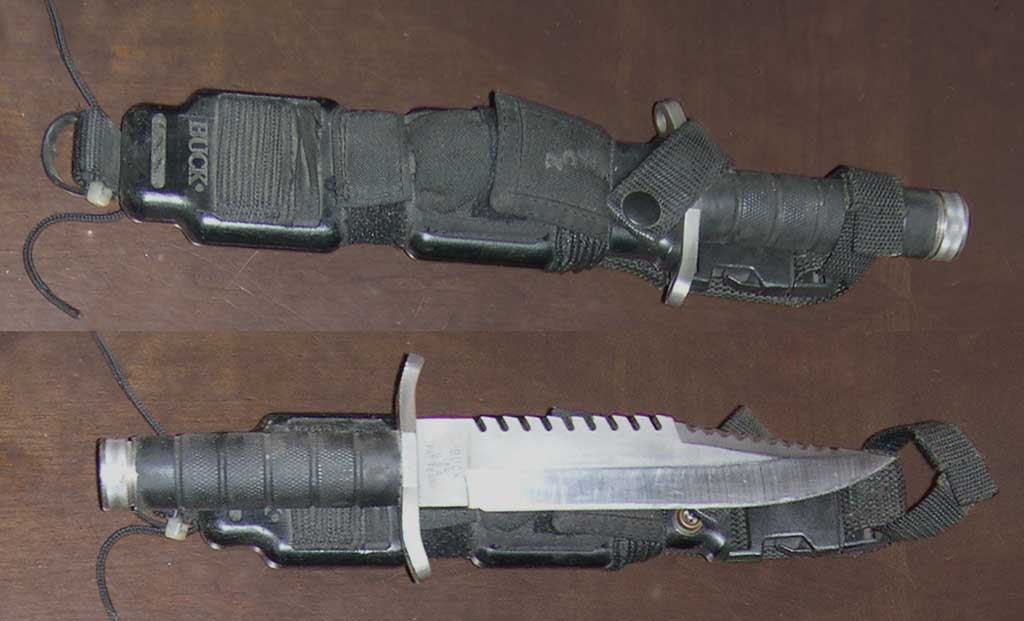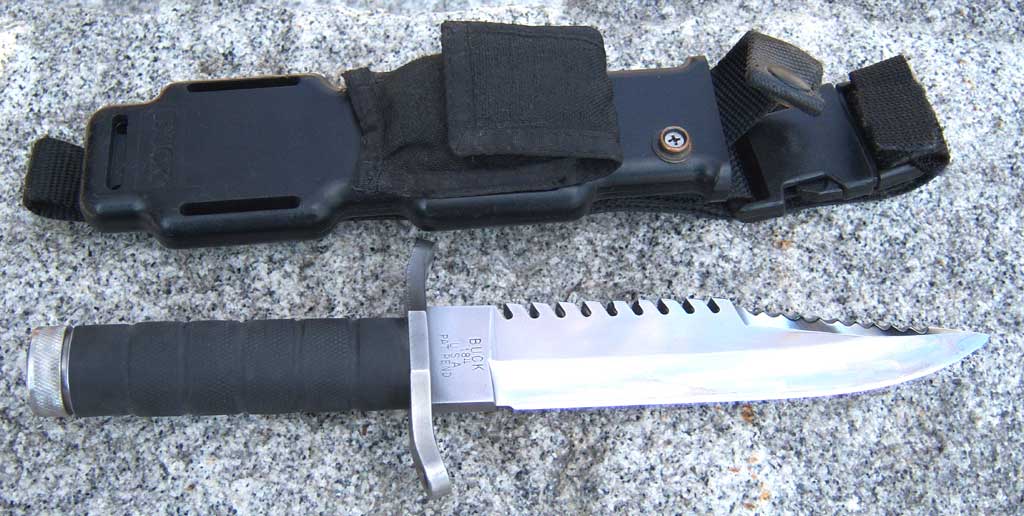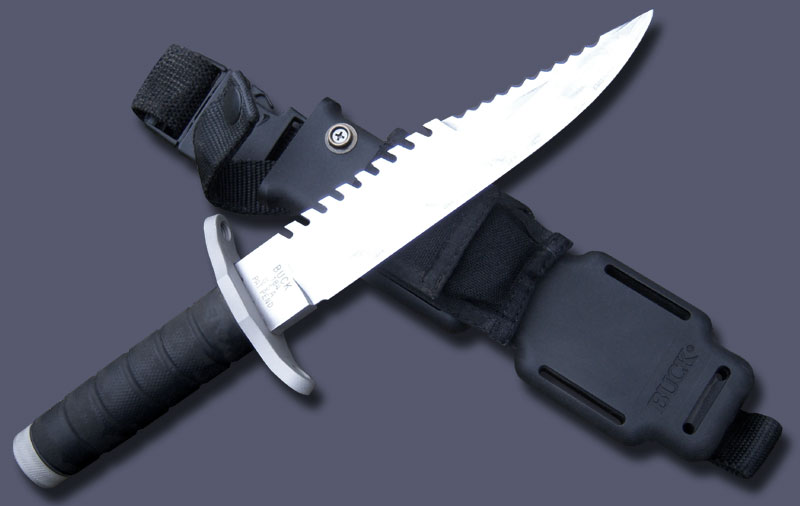 FIELD BLADE REVIEWS
FIELD BLADE REVIEWSAll Text, Graphics, Animations, Video, and Commentary on this website was created by, and is the intellectual property of m4040@m4040.com. All Rights Reserved. Unauthorized reproduction is punishable by up to a $500,000 fine or 5 years imprisonment for a first offense, and up to a $1,000,000 fine or up to 10 years imprisonment for subsequent offenses under the Digital Millenium Copyright Act (DMCA). Requests for use of this material should be forwarded to m4040@m4040.com.
 FIELD BLADE REVIEWS
FIELD BLADE REVIEWS
M40's "WORKING" Buck 184
The Buck model 184, or Buckmaster, was one of the first "survival" knives to hit the market back in the 1980's. It's become a bit of a collector's item lately, and will usually fetch anywhere from a couple hundred dollars to about $500 on Ebay depending on the condition. This blade was pitched to the military as an issued blade, and after some modifications, Buck won the contract. The modifications included a solid handle (no hollow storage area), and a guard and hilt that allowed it to be used as a bayonet on the standard M16 mounts. The 184 was thus the predecessor to the M9 bayonet, the current issue blade for our armed forces. Eventually, other manufacturers took over the contract including our nation's premier military blade maker, Ontario. Buck made the Buckmaster for several years, but eventually dropped the project.
Although many of you may consider this to be a form of blaspheme, my Buck 184 is actually a working blade, and has seen almost a quarter century of use and abuse. Yes, I regularly beat the crap out of a "collector's item". It has accompanied me over hundreds of miles of trail and many a day in camp (chopping wood, clearing trail, whittling, etc). Finally, it went with me through the United States Air Force Survival School in Washington state, and then on to multiple tours in the Middle East

It was not easy for a 15 year old to come up with the $150 or so dollars that this thing cost in the 1980's. My after school job paid about $4 an hour (before taxes), and I only managed about 15-20 hours a week. Even so, within a week of buying it, I decided that the balance was HORRIBLE. This blade was handle-heavy to the extreme. I chucked the end cap into a lathe and turned more than a quarter pound of un-necessary metal off of it, both from the backside and from the diameter. The balance is now right behind the guard on your leading finger (where it should be), and the diameter of the cap is the same as the rest of the handle.
The blade, sheath, pouches and straps have all seen better days, but are all holding up quite well. As for those silly "grappling" spikes that it came with, they have never seen even a single use, nor (I predict) will they ever.
The handle, which is renowned for tearing up hands during chopping and other tasks, has seen a large variety of grip tapes, foam covers and cord-wraps. All of these were attempts to tame it, but I finally settled on the rubberizing tool dip as shown above. The tool dip has also been applied to the retaining strap, which keeps it from fraying due to rubbing the handle. Notice that there is also a Velcro retaining strap added to the topside of the sheath. This keeps it from flopping around when worn. This was a major problem with the design, especially before I tamed the heavy end cap. There is also a good bit of cord wrapped here and there on the sheath for emergency use in the field.
My evaluation of this blade is that it has been a really decent tool (once properly modified). The steel is good, but on the hard side (I've never been a fan of stainless). This helps when edge holding is a must, but I suspect that it's a bit on the brittle side as well. As such I've never done any kind of hard prying with it.
Alas, the sentimental value of this blade usually has me leaving it home as of late. These days, I've been beating up younger, tougher blades instead. Some of the really good ones include Becker Brutes, Kershaw Outcasts, and most recently, a Cold Steel San Mai Trailmaster. I recommend these highly.
I've also seen fit to beat up a lot of aftermarket khukri's. Most are great values, but some are not worth the asking price.
FIND OUT WHICH KHUKRI'S ARE WORTH THE ASKING PRICE, AND WHICH ONES ARE JUNK!
Anyone else out there have an old 184? Send me some pics!
ADDENDUM
I recently decided to clean my old Buckmaster up a bit. It was looking quite abused as you can see in the pictures above.
First, I removed all the old cord and straps from the sheath. A 3M pad and some scrubbing in soapy water cleaned up the bulk of the dirt and grime.
I then went to work on the blade. At first I considered simply bead-blasting it (this hides scratches and hacks very well). Instead, I decided to see if I could make it look a bit nicer. I took the blade to a few successively finer belt grits to remove the scratches and hacks. Then I buffed it out with a little rouge. It was more work than sandblasting, but the end results were well worth it. A fresh tool dip and a mild wire wheel got the handle back to a comfortable, matte black rubber.
I gotta say... it did clean up nice, especially considering the condition it was in when I started!

After a little more work, it's really getting there. I sandblasted the guard, endcap and sheath to smooth out scratches, then did some more buffing on the blade.

Return to M40's Ghurka Modification Page